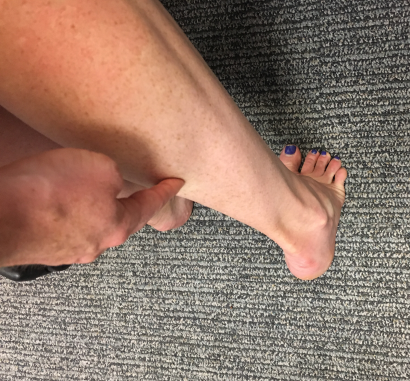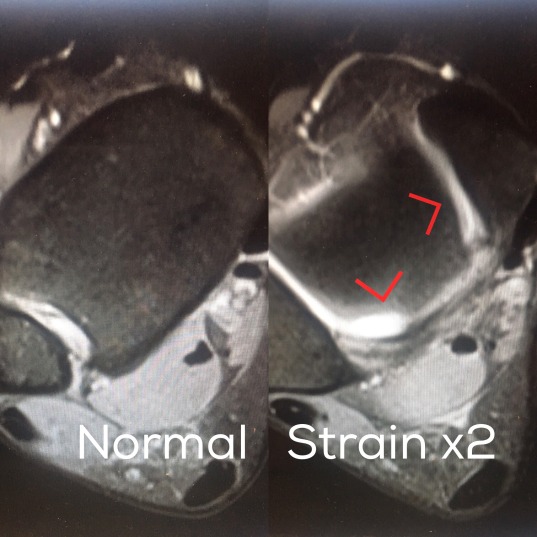The past year has been a tough one for me running wise. I injured my calf almost exactly one year ago and the road to recovery has been far from smooth. I’m happy to say now, though, that the future finally looks bright.
During my road to recovery, my blog also took a hit. After all, it’s hard to stay motivated to update a running blog when you run into obstacle after obstacle. You start to fear that your optimistic posts somehow jinxed you. But today, I want to look back and recap those many ups and downs.
This post is going to be a long one, but I want a record of everything I went through for the future. It’s so easy to forget how bad things once were when things start going well. Perhaps someone else will find them useful, especially anyone considering an autologous blood injection.
So, where did this all start?
Last July, I wrote about an issue I was having with my calf right at the musculo-tendinous juncture where the Achilles’ tendon meets the base of the gastroc muscle. I even shared a picture of the location! (Spoiler alert: I was spot on with that location.)

In that post, I wrote about dabbling with the Team Beachbody’s Insanity Max: 30 program, which left my calves rock solid after every video. I told you all how I didn’t know exactly what the problem was, but that I was leaning toward Achilles’ tendonitis and that I didn’t think it was a strain.
Do you know what I didn’t write about? Going to the doctor. Because I was stupid. I decided I knew enough to deal with the issue on my own – a decision I deeply regret now.
The Progression
From August through November, my running was very on-again / off-again. I wrote about taking time off for my injury–a week here, 10 days there–before getting back to training. Then, inevitably, a race or a workout would lead to more time off. Looking back, it makes me cringe. Why did I play that game for so long? Why didn’t I go to the doctor?
In retrospect, I did an impressive amount of running during this time considering just how bad my calf injury was. If I have one thing going for me, it’s my pain tolerance. I even ran a few PRs with what turned out to be the mother of all calf strains! I complained about Achilles’ tendon pain after each and every race, but I kept at it. I even aborted a workout in late September, only to stubbornly run a 10 mile race in October.
The straw that broke the camel’s back, however, was a workout the week after my Turkey Trot. I finally—more than four months after the original injury—set up an appointment with my doctor.
The Diagnosis
All along, I had been operating on the assumption that I had tendonitis. The doctor, however, was pretty sure that it was muscular. I had an MRI on December 10, which confirmed this suspicion. I had not one, but two soleus strains. One was minor, near the tibia. The other was major – a “full thickness tear” running straight through my calf from the tibia to the Achilles’. Think of it as a worm hole through your muscle.

The big problem here–and what ultimately doomed me–is that the vast majority of calf strains are in the gastrocnemius muscle, not the soleus muscle, where I had my strain. And my strain was SUPER close to the Achilles’ tendon (one doctor was actually shocked that I didn’t tear the tendon with a strain so close). So when I was being stupid and trying to self-diagnose, my symptoms sounded more like Achilles’ tendinitis than it did a “traditional” calf strain.
When I look back, it makes more sense now. Here’s one passage I found in a National Institute of Health report:
“Unlike the gastrocnemius the soleus is considered low risk for injury. It crosses only the ankle and is largely comprised of type one slow twitch muscle fibers. Soleus strains also tend to be less dramatic in clinical presentation and more subacute when compared to injuries of the gastrocnemius. The classic presentation is of calf tightness, stiffness, and pain that worsen over days to weeks. Walking or jogging tends to provoke symptoms. Swelling and disability are generally mild.”
All of that really struck a cord with me. Particularly the part about the slow-twitch muscle fibers, since that helps explain why speed work and races were what really did me in.
The Recovery
The doctor originally told me to take four to six weeks off running, and that then I should be fine. Turns out, however, I really did a number on my calf with the constant injury/partial-recovery cycle and the healing process didn’t run smoothly.
I did begin running again in January, but after five weeks, things didn’t feel quite right. This time, I wasn’t going to mess around and I went straight back to the doctor. An ultrasound confirmed not only that my calf was still strained, but that the injury was still massive. The ultrasound revealed a tear of the medial soleus measuring 5.1 cm x 0.4 cm x 2.0 cm.
I proceeded to have ultrasounds monthly through April. I had a big improvement in March, with the tear then measuring 2.7 cm x 0.3 cm x 0.6 cm, before a complete stagnation. In April, the strain only improved to 2.3 cm x 0.3 cm x 0.6 cm. It is then that the doctor and I decided it was time to try something more drastic.
The Autologous Blood Injection and Aftermath
On May 8, my orthopedic doctor took a vial of blood from my arm and injected it right back into my leg, using an ultrasound to get the needle exactly into the site of my calf tear. While the procedure itself wasn’t bad (they used local anesthesia on my leg), the recovery was a little rough.
The procedure re-trigger the acute phase of the injury by irritating the exact location of the tear. With the injury site re-irritated, all that extra blood was on hand to aid in the full healing response of the body. The pain I had was nearly identical to the pain I would have whenever my injury would flair up – but more intense.
The doctor proscribed lots of rest and NO painkillers. After all, painkillers interfere with the body’s natural healing response, and we were depending on that response running its course.
I worked from home for two days after the procedure and tried to avoid walking as much as possible. Then I used the crutches I had laying around from my stress fracture back in 2014 for a few days. I finished the day after the injection with an impressively low 793 steps on my FitBit and averaged less than 5,000 steps the rest of the week (including steps with the crutches).
While I had been spinning a lot before the injection, as well as attending weekly barre classes, I didn’t do any kind of exercise for two weeks after the procedure. When I did return to exercise, it was only some light spinning for another three weeks (I also got my wisdom teeth out during this time…so that helped force some rest).
A month after the injection, on June 5, I returned to the doctor for a follow up. I wasn’t convinced the calf was any better off, because after attending a wedding over the weekend, I apparently danced too hard and the muscle was super sore. Apparently, though, it was just good soreness.
The doctor performed an ultrasound and said the hole in my calf was gone, but that the muscle was still remodeling and wasn’t yet as “smooth” as he would like. The doctor suggested I wait a week, and then start running on an Alter-G anti-gravity treadmill.

Another month later, on July 6, I returned to the doctor for another follow up after running on the Alter-G a dozen times, getting up to 40 minutes and 85% of my body weight, plus three runs outside of about 20 minutes each.
I got good news: my calf is still looking good. The doc said there was one spot that still didn’t look perfect, but that if he hadn’t known about the strain, he would have thought it was normal muscle.
Moving Forward
The doc recommended another four to six weeks of physical therapy, but other than that, he said I don’t need to do any more follow ups unless I feel any pain. That means today, 51 weeks after my initial injury, I can finally look forward to the future with some (well-founded) optimism and clarity.
It is time to rebuild my base, slowly but surely. It’s a daunting endeavor, but I’ve been here before (if not after quite so much time off). I can guarantee I will have anxiety about my calf for months to come, and any kind of speed work is still months away, but I am so excited to once again be moving forward.
Here’s to many more race reports in the years (if not the months) ahead.

I’m so happy you got a good report at the doc and glad to see you running on the Alter-G as well as doing some spin and barre. I was thinking about you and your doctor’s appointment and think it is good you recaped your injury and the injection. You never know who may have this issue and consider that and read your recap. Cheers to rebuilding your base and hopefully staying injury-free for the rest of 2017- you have overcome so much with the stress fracture as well as other issues that you will no doubt come back strong from this.
LikeLike
Thanks, Amy! I hope you are right 🙂
LikeLike
I read the entire post (didn’t think it was too long at all) and it’s good you were able to document everything that happened. That really sounds like a tough situation, both physically and mentally. As you said, the good news is that there is a path forward and you should be done with this injury in the near future. It also sounds like your doctor really knows his stuff and that the procedure really helped stimulate recovery. Looking forward to more posts.
LikeLiked by 1 person
Glad to hear you were able to make it through the whole thing and that it didn’t feel too long 🙂
I’m definitely lucky to have found this doctor. I really do think he made all the difference!
LikeLike